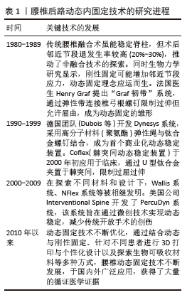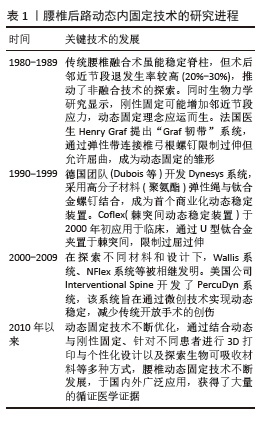Chinese Journal of Tissue Engineering Research ›› 2026, Vol. 30 ›› Issue (3): 711-720.doi: 10.12307/2025.879
Previous Articles Next Articles
Intervertebral disc rehydration after posterior lumbar dynamic internal fixation
Wang Peng1, Li Zhijun2, Zhang Shaojie2, Wu Yimin1
- 1Second Affiliated Hospital of Inner Mongolia Medical University, Hohhot 010000, Inner Mongolia Autonomous Region, China; 2School of Basic Medicine, Inner Mongolia Medical University, Hohhot 010000, Inner Mongolia Autonomous Region, China
-
Received:2024-12-02Accepted:2025-03-01Online:2026-01-28Published:2025-07-07 -
Contact:Wu Yimin, Professor, Chief physician, Master’s supervisor, Second Affiliated Hospital of Inner Mongolia Medical University, Hohhot 010000, Inner Mongolia Autonomous Region, China -
About author:Wang Peng, Master candidate, Second Affiliated Hospital of Inner Mongolia Medical University, Hohhot 010000, Inner Mongolia Autonomous Region, China -
Supported by:Inner Mongolia Autonomous Region Capital Area Public Hospital High-level Clinical Specialty Construction Science and Technology Project, No. 2024SGGZ087 (to WYM); Inner Mongolia Autonomous Region Science and Technology Plan Project, No. 2021GG0395 (to WYM)
CLC Number:
Cite this article
Wang Peng, Li Zhijun, Zhang Shaojie, Wu Yimin. Intervertebral disc rehydration after posterior lumbar dynamic internal fixation[J]. Chinese Journal of Tissue Engineering Research, 2026, 30(3): 711-720.
share this article
Add to citation manager EndNote|Reference Manager|ProCite|BibTeX|RefWorks

2.2 腰椎后路动态内固定术 脊柱融合术因在短期内的稳定效果可靠且可显著提升脊柱稳定性,在过去常被视作处理腰椎问题的首选“标准手术方法”,联用特定设计以固定脊柱的器具及材料后,骨骼整合效能显著提升[8]。尽管采取了有效措施,但仍可能遇到若干问题,包括但不限于:假体关节的不真实形成、植入物的移位或松动、固定螺钉的断裂以及邻近椎节的退化性改变,具体表现为相邻节段退行性变化和邻近节段退行性疾病。特别是相邻节段的退行性病变,这一议题近来备受关注,已被广泛认同为决定手术长期成效的关键因素之一[9]。因此,学者们期望通过实施动态的、具有弹性的固定技术,保留特定固定节段的同时促进其运动能力,以此策略有效预防或延缓相邻节段可能出现的退行性变化[10]。动态内固定技术不仅保持了病变区域部分的活动能力,还巧妙地调整了各节段间的应力分配模式,这一创新设计能有效地预防手术恢复期间相邻节段可能产生的应力过度集中及过度使用现象,从而为患者提供更为安全、有效的治疗方案。此革新策略预期能推动动态固定术后手术区域椎间盘组织的再水化进程,从而加速恢复进程,显著提高患者的日常生活质量[11]。当前,广泛应用于临床的动态内固定技术主要包括棘突间动态内固定系统,如Wallis系统、X-stop系统、DIAM系统以及Coflex系统等;椎弓根动态内固定系统,包括Graf系统、Dynesys系统、FASS系统、Isobar系统、NFlex系统、Bio-Flex系统、WaveFlex系统、DSS系统、Cosmic系统等[12]。尽管现今的动态内固定系统在理论上提供了高度的灵活性和适应性,但实际应用仍主要依赖于传统的开放手术方法来进行置入操作。传统开放式手术往往涉及剥离椎旁肌肉、脊柱周围的韧带系统以及椎管内正常结构,此类操作不仅会导致周围组织遭受显著损伤,还可能增加术后感染等风险[13]。这一现状反映了当前医疗技术对完全无创或微创置入解决方案的持续需求,以及对改进现有手术技术以减少患者创伤和恢复时间的不懈追求。随着生物材料科学、机器人技术及导航系统的不断进步,更加精确、安全且侵入性更小的脊柱微创技术的蓬勃发展,各种新技术井喷式出现并广泛应用于全球临床实践。脊柱微创技术以其在治疗脊柱疾病领域的显著优势与巨大潜力,成为了现代医学的重要组成部分,为患者带来了更加精准、安全、高效的治疗方案[14]。 相较于传统的手术方法,脊柱微创技术的显著优势在于带来的轻度疼痛、显著减少的出血量、极小的创伤面、快速的恢复速度以及缩短的住院时间,这些特点共同体现了它在现代医学领域的先进性和优越性。学者们精心设计了创新的可经皮微创置入的动态内固定系统,旨在提供更安全、更便捷的治疗方法,如 Superion系统、APERIUS系统、In-space系统、Bullet系统、PercuDyn系统等[15]。 2.3 开放动态内固定系统 当前,针对具备手术适应证的椎间盘退变患者,尤其是退变较复杂的患者,首选治疗策略是实施腰椎后路椎间融合内固定术(posterior lumbar interbody fusion,PLIF)[16-18],此手术方法可显著减轻患者的疼痛症状,通过重建脊柱稳定性,改善其生活质量。然而,坚强的内固定与椎间融合技术虽能有效稳定脊柱,但往往伴随软组织破坏严重、术中出血量显著增加以及可能导致邻近节段加速退行性改变等并发症,对患者长期生活质量造成影响。为了克服传统PLIF术在应用中的各种局限性与挑战,适应复杂人体结构的精确分析需求,开放动态固定的创新理念被适时提出并广泛应用,这一理念不仅引入了动态调整机制以适应结构变形,还提供了更为灵活的固定条件设置,使得在处理腰椎活动度等问题上能够更加准确和高效[19]。开放动态固定技术涵盖了棘突间动态内固定系统与椎弓根动态内固定系统两大类,此文将聚焦于Coflex系统与Dynesys系统,以此为案例深入探讨并总结棘突间动态内固定系统和椎弓根动态内固定系统的最新研究进展以及应用趋势。 2.3.1 Coflex系统 20世纪90年代,法国的JACQUES SAMANI博士创造性地研发并设计了一款专为临床应用的椎间U型固定器械,这一创新性的医疗工具为脊椎手术领域带来了革命性的变化。基于U型装置的卓越性能和临床效果,该技术得到了广泛的应用与认可,并在此基础上,经过进一步的研发与优化,改进后产品被正式命名为Coflex,这款设备在保持椎间U型固定器械原有优势的同时,又融入了更多人性化设计与技术创新,成为现代脊椎外科手术中不可或缺的重要工具[20]。自2006-04-12,美国食品药品监督管理局(FDA)批准了Coflex动态稳定设备的临床研究以来,这一创新技术已在全球范围内广泛应用于脊椎疾病的治疗,展现出了卓越的安全性和有效性。采用Coflex系统的手术流程为:患者接受全身麻醉并采取俯卧姿势,通过C型臂X射线机的透视定位,在手术区域的背部中央开一个长约5 cm的切口,采用沿中线锐性分离软组织的技术,确保棘上韧带的完整性得以保留。这一操作方法能够充分地显露双侧椎板与小关节区域,从而实现精准手术,同时避免了棘突基底骨性结构的破坏,保证了脊柱稳定性的同时也最大限度地减少了手术风险和恢复时间。在切除棘间韧带与黄韧带之后,对中央管进行开窗以实现充分减压,并精细显露后方的硬膜囊区域;然后根据需要适当扩大侧隐窝和神经根管中的狭窄部分,以达到缓解压迫、改善神经功能的目的,在确保充分减压并放置试模后,通过透视观察确认手术区域的脊柱节段呈现轻微后凸状态;随后选取与当前试模尺寸相匹配的Coflex型号,精确地置入椎间动态固定装置。留置负压引流管后,患者通常在24-48 h后进行拔除,并开始下床活动,以促进恢复与预防并发症,逐步加强腰背肌锻炼,并实施为期2周的腰围保护措施。 从何明长等[21]的结果看来,对比PLIF术,Coflex组的手术时间以及住院时间较PLIF组明显缩短、术中出血量较PLIF组显著减少;2种术式术前、术后3年与最终随访阶段的目测类比评分及Oswestry功能障碍指数比较,并未显示出统计学差异,这表明长期随访结果中患者的疼痛程度和功能障碍并未出现明显变化;但是在最后一次随访时,Coflex组手术区域的椎间活动度显著高于PLIF组,Coflex组在随访期间邻近节段退行性病变的发生率低于PLIF组。 Coflex系统的设计理念创新性地追求双重目标:既有效地撑开棘突,又能严格限制腰椎的后伸运动,以此精准实现脊柱的稳定性调节[22]。Coflex置入术后能够显著提高棘突间的间距,从而增加椎体后缘的高度,这一变化可直接减少椎间盘后部所承受的压力,进一步扩大了神经根管的空间。同时,Coflex所产生的张力能够促使相应腰椎节段发生后凸变化,从而逆向拉伸黄韧带,从而减少其褶皱,且在手术过程中,会对黄韧带以及过度生长的关节突进行部分切除,最终达到增加椎管容积的效果,有效地缓解椎管狭窄问题,进而改善患者的临床表现[23-24]。CHEN及团队[25]在为期3年的跟踪研究中对比了Coflex手术组与融合手术组的效果,结果显示,两组在目测类比评分和Oswestry功能障碍指数的改善幅度上表现出相当的临床疗效,差异无显著性意义;然而,Coflex手术组的邻近节段退变发生率仅为13.1%,明显低于接受融合手术患者的26.1%,表明相较于融合手术,Coflex手术在减少邻近节段退变方面展现出更显著的优势。在术后2年的跟踪观察中,李冬月及其团队[26]发现所有患者的目测类比评分与Oswestry功能障碍指数均显著优于术前的状态;Coflex组(Coflex置入节段为L3-4,与上位邻近节段L2-3椎间活动度之和)与融合固定组(上位邻近节段为L2-3椎间活动度)之间无显著性差异。Coflex策略创新性地将生物力学负荷从单一节段(如L2-3椎间盘)分散至其相邻的2个节段,这一分配机制显著降低了任何特定节段承受过载压力的概率,进而有效地减少了该区域退行性病变发生的可能性。 与PLIF相比,Coflex系统在治疗腰椎疾病领域展现出显著优势,主要体现在以下几个关键点:①手术时间短:Coflex系统的操作通常更为快捷,减少了手术所需的时间,这对于缩短患者术后恢复周期、减少麻醉风险具有重要意义。②术中出血量少:通过精准的微创技术,Coflex系统能够有效控制术中出血,降低输血需求,减轻患者的生理负担。③住院时间短:得益于上述两点优势,采用Coflex系统的患者往往能更快地从手术状态中恢复,从而缩短住院时间,提高了医疗资源的利用效率。④手术节段椎间活动度大:Coflex系统设计旨在保持并增强椎间盘和周围组织的自然活动度,这对于维持腰椎功能、促进长期康复有着积极作用。⑤邻近节段退行性改变发生率较低:传统手术或某些介入治疗方法有时可能因对椎间盘过度干预而引发邻近节段的退变加速。Coflex系统通过提供局部稳定而非融合整个节段的方式,有助于减少这种潜在风险,保护未受直接干预的椎间盘健康。综上所述,Coflex系统在治疗腰椎疾病时不仅提供了更为安全、高效的手术方案,而且在提高患者生活质量、缩短治疗周期、减少并发症风险等方面表现出色,成为现代腰椎疾病治疗领域的重要选择之一。 自从Coflex动态稳定系统的诞生,医疗专业人员持续对它进行了优化与创新,旨在实现更优的治疗成果。GUO等 [27]对Coflex装置进行了基于拓扑优化成型的改进,这一创新导致其体积缩减了约8%;改进后的Coflex装置在应力分布上表现出显著优化,平均应力显著下降,其生物力学性能更加接近人体脊柱的特性。这一改进有效地降低了棘突骨折以及植入体(假体)损坏的风险,为患者提供了更为安全、舒适且长期有效的治疗选择。鉴于S1棘突的长度较短这一事实,普遍观点是Coflex 技术并不适用于L5/S1这一节段。CHEN及其团队[28]精心设计了一种创新性的基于椎弓根螺钉的“M”形杆状支撑结构,采用双侧椎弓根螺钉提供稳固支撑,结合M形杆的特定凹陷设计有效承托上部棘突,此设备不受微小间隙的影响,成功解决了S1棘突长度不足的难题。IntraSPINE作为一种新颖的椎板间动态稳定装置,显著提升了节段的稳定性,有效降低了椎间盘所承受的压力,进而改善了患者的临床症状,这一创新为临床医师们提供了全新的治疗参考与选择方案。 2.3.2 Dynesys系统 Dynesys系统称为动态中和稳定系统,是一种应用于腰椎手术的动态内固定装置,相比以往的钛棒坚强固定而言,Dynesys动态稳定系统在确保手术区域稳固的同时,保留了特定脊柱节段的一定程度的活动度,最大限度地保留了腰椎的自然功能。这一设计旨在预防因手术造成的邻近节段退行性变化,实现更全面的治疗效果与患者生活质量的提升[29]。Dynesys 系统由法国的DUBOIS于1991年率先设计,对传统的Graf韧带系统进行了优化升级,该系统于2007年正式引入中国市场并开始应用于临床[30]。生物力学研究揭示,Dynesys动态内固定系统凭借其聚合物组件的交互作用,实现了对腰椎固定区域的有效保护。该系统利用聚对苯二甲酸乙二酯绳索与聚碳酸酯-聚氨酯套管之间的微小相对运动,巧妙地保留了腰椎部分活动度,既确保了关节的自然功能,又维持了整体结构的稳定性。具体而言,聚碳酸酯-聚氨酯套管限制了腰椎的过度伸展,有效防止了不必要的压力与损伤;同时,聚对苯二甲酸乙二酯绳索则负责阻止腰椎的过度屈曲,进一步强化了腰椎区域的稳定性。这种设计不仅减少了固定节段内部的应力集中,降低了因过度活动导致的损伤风险,同时还有助于减轻固定节段及其相邻节段的负担,有效降低了邻近节段因承受额外压力而导致的退变发生,从而为患者提供了更为安全、有效的治疗方案[31]。 当前,安置Dynesys动态内固定系统的方法主要有2种:传统的暴露手术与双侧肌肉间隙入路技术。根据范红松[32]的研究,采用后路经肌间隙椎弓根螺钉进行内固定治疗腰椎病患者,其治疗策略不仅有助于保障椎管的畅通与病变椎体高度的恢复,还显著减少了术中出血量和术后引流的需要,有效减轻了患者术后腰背部疼痛感。在张海飞及其团队[33]的研究中,肌间隙组患者的切口长度明显短于常规组,且在手术过程中产生的出血量与术后引流物的产生量均少于常规组,从而导致平均住院时间也显著短于常规组;在术后1,3个月的随访中,所有患者的目测类比评分和Oswestry功能障碍指数相较于术前均显著下降,而功能评估指标日本骨科协会评分则呈现上升趋势;特别值得注意的是,肌间隙组在术后1个月时,其目测类比评分和Oswestry功能障碍指数相较于常规组更低,日本骨科协会评分则更高。经肌肉间隙入路Dynesys系统动态固定手术流程如下:患者实施全身麻醉并采取俯卧姿势,腰部支撑以保持稳定,通过透视设备进行精确定位。随后对操作区域进行严格的消毒处理,并铺设无菌手术单。以确定病变椎间盘所在的节段为焦点,施行腰背部正中切口,切开皮肤、在皮下层与腰背部筋膜之间,采用Wiltse入路技术,精准穿过多裂肌与最长肌间的间隙,从而成功暴露两侧的关节突关节外侧以及横突根部区域。在双侧椎弓根精确置入引导针,确保透视下达到理想位置后,各精准拧入1枚椎弓根螺钉;随后通过绳缆将透明皮管套接于螺钉上,利用绳缆工具实现紧固,确保两侧操作同步进行,依次连接动态稳定绳索,并配以相应长度的透明皮管,以此有效缩小间隙,提供稳固支撑。术中透视显示椎弓根钉位置精确无误,未发现活动性出血,核对所有器械与物品确保无误后,进行冲洗操作,并正确安置负压引流管。 殷涛等[34]的研究结果发现,术后末次随访时目测类比评分从术前的7.1±1.2降至1.6±0.6,Oswestry功能障碍指数从67.64±9.30显著下降至17.65±3.07,这一变化具有统计学意义;在术后6个月及最终随访中,虽然维持了与术前相同稳定节段的平均活动度范围,但相较于术前,各稳定节段的平均活动度范围显著降低。然而这种降低并未完全消除固定节段的活动度,表明手术在减少疼痛和改善症状的同时,仍保留了一定程度的脊柱运动功能。Wiltse入路Dynesys动态系统的显著优势在于其微创特性及肯定的临床疗效,该方法不仅能够有效地减轻患者的疼痛感,还能维持椎间隙的高度和活动范围。 在一项临床研究当中,刘杰及团队成员[35]对25例患者进行了对比研究,分析了Wiltse入路动态系统(Dynesys)内固定的长期临床效果与PLIF在治疗腰椎间盘突出症时的疗效差异,获得了不少于9年的随访。Dynesys手术的实施时间、过程中产生的出血量以及住院恢复期均明显低于PLIF手术组;在术后3年及最终复查阶段,两组患者的目测类比评分与 Oswestry 功能障碍指数均较术前有所改善。在最终复查阶段,两组患者在手术区域的活动范围均较术前明显减少、Dynesys组中涉及手术的关节平均活动度范围显著大于PLIF组。 Dynesys系统治疗腰椎疾病时的显著优势在于对椎间组织的广泛处理需求较少,无需进行植骨融合,所采用的器械也相对简便,这有效地缩短了手术时间。相比其他手术方式,Dynesys系统避免了融合过程中的并发症,比如骨供体区的疼痛、血肿形成以及骨折等问题[36]。而传统融合手术过程中出血量通常较多,这主要与较长的手术时间紧密相关,同时,在手术中彻底移除软骨板也会导致椎体间的渗血现象,进一步增加了出血量。另一个重要区别在于住院时间及术后恢复速度,使用Dynesys系统的患者通常能享受到较短的住院时间和更快的恢复期,这不仅提升了患者的舒适度,也为医院节省了资源,提高了医疗服务效率[37]。综上所述,Dynesys系统以其独特的技术特点,在减少手术风险、缩短手术时间及促进患者快速康复等方面展现出明显的优势。自腰椎非融合手术实施以来,Dynesys内固定系统因其独特的非融合特性,已成为此类手术的主要选择和典型代表,它既确保了手术区域的稳固,又保留了一定程度的灵活性,从而在短期内取得了令人满意的治疗效果,并且长期来看,效果也得到了广泛认可。 Dynesys动态内固定系统在实施过程中无需进行椎间融合手术,这一设计显著降低了手术期间对椎体及其周边软组织的医源性损伤,并有效缩短了手术时长;它的独特之处还在于,在确保腰椎特定节段稳定性的前提下保留了该节段的完整运动功能,从而优化了手术节段的负荷分布与传导,提升了患者术后恢复的质量和速度[38]。然而,Dynesys系统仍旧伴随着一系列常见的并发症,例如置入该系统的患者术后出现螺钉松动的并发症概率与融合手术相比较高;至于预防邻近节段退行性疾病,尽管Dynesys系统在理论上具有一定的优势,但实际能显著降低邻近节段退行性疾病发生率的有效性仍存在不确定性。ZHANG等[39]经过6.6年的追踪观察,影像学诊断显示邻近节段退行性疾病发生概率为16%。在PAYER等[40]为期2年的跟踪观察期间,发现30例患者中有3例(占10%)出现了术后螺钉松动现象,这一发生率与传统腰椎手术的结果相当。为了有效减少Dynesys动态稳定系统置入手术后的螺钉松动现象,学术界和临床实践共同聚焦于提升螺钉与骨组织的结合质量这一关键点,旨在显著降低螺钉松动以及可能伴随的螺钉断裂等并发症的出现概率[41]。通过优化手术技术、选用更高质量的置入材料、以及实施个性化的术后康复方案,医学专家们正不断探索并实践能够增强螺钉稳定性、促进更快愈合、并最终提高患者生活质量的方法。这些努力不仅基于对现有知识的深入理解,也包含了对新型材料、生物相容性、以及生物力学性能的持续研究,旨在为患者提供更为安全、有效的治疗选择。最为突出的成功案例之一便是采用等离子喷涂技术处理的羟基磷灰石螺钉,相较于仅使用钛合金钉,引入生物活性钛植入物显著提升了成骨细胞的黏附性和分化能力。在组织学层面,骨-种植体界面与矿化骨基质或类骨质截然不同,其显著特征在于高密度的蛋白多糖和糖蛋白存在。 2.4 经皮动态内固定系统 腰椎后路动态内固定技术的开发与实践正快速进步,然而,目前该技术的实施大多依赖于开放式手术。相较于传统的开放式动态内固定手术,微创减压联合非融合固定在腰椎间盘突出症的治疗中展现出更显著的微创特性[42],这种手术方法不仅减少了对周围组织的创伤,还降低了术后恢复时间,体现了现代脊柱外科追求的最小侵入性原则和长期疗效与生物力学稳定性的平衡。通过精准定位和精细操作,微创减压能够有效解除神经压迫,而附加的非融合固定策略旨在促进自然愈合过程,减少人工材料对脊柱结构的干扰,从而更好地适应个体差异,提高患者的生活质量。这一治疗方法的采用,标志着腰椎间盘突出症治疗领域向着更加个性化、功能保护和长期效果优化的方向发展[43]。当前,经皮动态固定技术常与内镜手术结合应用,涵盖了棘突间动态内固定系统及椎弓根动态内固定系统两大类。棘突间动态内固定系统包括了Superion系统、APERIUS系统、 In-space系统、Bullet系统等;椎弓根动态内固定系统主要为PercuDyn系统等。此文将以In-space系统和PercuDyn系统为代表,分别归纳总结棘突间动态内固定系统和椎弓根动态内固定系统的研究进展。 2.4.1 In-space系统 In-Space 技术是一种非融合式的经皮棘突间动态固定方法,它通过在微创环境下置入器械,从而在保留脊柱的生物力学特性以及手术区域的运动能力的同时,有效地维持脊柱的稳定性。与传统的刚性融合手术相比,这种方法能显著减少术后并发症,并避免刚性融合可能带来的限制。此外,In-Space 技术还包括通过椎间孔镜进行髓核摘除和减压的步骤,可给患者带来极高的微创效益,不仅能减轻患者的疼痛、缩短康复时间,还能减少对周围组织的损伤,提供更为安全、有效的治疗方案[44]。In-Space 技术具体操作方法为:患者在麻醉支持下采取俯卧姿势,在G型臂X射线仪器的透视引导下,精确识别并标记出病变所在的椎间隙。取病变椎间盘水平线上、沿脊柱后正中线向旁开12-14 cm处为进针点,以尖刀精确切开皮肤约7 mm,通过所作切口,沿着侧后方向缓缓刺入病变区域的纤维环部位。在X射线透视的辅助下,通过穿刺针引入导丝,沿着导丝以从细至粗的方式逐步插入套管,当遇到骨质结构时,则使用环钻进行扩孔处理,确保路径顺畅。最终目标是使工作套管深入纤维环2.0-3.0 cm,以完成精准介入治疗的准备阶段。实施椎间孔镜手术,旨在直观地评估椎间盘的髓核与纤维环状态,此过程允许医生精确地探测并评估行走神经根与出口神经根的状态。随后,彻底清除已退变髓核组织以及神经根周围突出组织,以恢复脊柱功能,减轻患者疼痛。反复清除残留的髓核物质,射频止血、执行封闭、成型开窗纤维环的切割,并移除外套管。将椎间孔镜的切口扩大,通过侧位透视精准地插入导针,接着,沿此切口方向,操作导针深入至棘间区域,最终步骤是确认导针准确地定位在手术节段的棘突之间。采用分阶段使用扩张套筒沿着引导针的方式,直至达到与棘突上下边缘紧密贴合的状态。在前后位X射线透视的引导下,借助配套的精确机械辅助工具,成功置入合适的In-Space棘间动力装置,调整装置的位置至最佳状态。完成定位后,适时打开了侧翼,整个过程确保了高精度和安全性。在G型臂X射线机的透视下,观察显示In-Space棘间动力装置位置极为理想,棘间间隙令人满意,清洗伤口,安置引流管,缝合包扎切口[45-46]。 棘突间撑开装置作为一种动态且非融合的医疗技术,专门用于扩大病变节段的棘突间隙,以防止脊柱过度后伸。这一创新设计增加了特定水平上的椎管横截面积与椎间孔的高度,有效减轻了椎间盘与小关节的负载,同时提升了椎间隙的高度,精准控制了不正常活动,从而维持了脊柱的运动功能。有研究对25例腰骶部退行性疾病的患者行In-Space微创置入术,随访1年后Oswestry 功能障碍指数改善52%,目测类比评分改善57.8%,除个别病例中植入物轻微下移外,未报告任何并发症[47]。HRABáLEK及其团队[48]研究发现,椎间孔镜辅助的In-Space固定技术与传统腰椎后路椎体间融合方法相比,显著提升了术后脊柱的稳定性,有效减少了椎间隙高度丢失,并成功降低了患者的术后疼痛程度,同时大幅度降低了并发症的发生率。这一创新性治疗方法不仅保留了更多正常的脊柱结构和功能,还通过微侵袭的技术路径,使得手术创伤显著减小,恢复期更为迅速,为患者带来了更优的治疗体验和长期预后。冯志杰[49]针对89例单节段腰椎间盘突出症患者实施了椎间孔镜下的In-Space固定术与传统的PLIF融合内固定术,并进行了对比研究,结果显示,采用In-Space固定术的患者在手术过程中的出血量和术后引流情况均明显优于PLIF传统方法,且平均卧床时间和住院时间也显著缩短;在并发症方面,In-Space固定术的总体发生率也显著低于PLIF传统融合内固定;从长期效果来看,In-Space固定术在术后12个月时,相邻节段的腰椎活动度较PLIF组显著增高;同时,椎间隙的高度也显著高于接受PLIF传统融合内固定的患者。 这项研究表明,In-Space固定术在治疗单节段腰椎间盘突出症时,不仅在短期恢复过程中展现出更优的效果,包括减少出血、缩短康复时间、降低并发症风险;而且在长期效果上,能够维持更好的腰椎活动度和椎间隙高度,为患者提供更为有效的治疗选择。安博等[47]进行临床研究后得出了相似的结论。综合考虑,椎间孔镜与经皮棘突间动态固定联合应用展现出显著的微创优势,同时能有效保持脊柱的活动性和稳定性,无疑是目前理想的微创手术策略。 尽管In-space系统在治疗腰椎疾病方面展现了一定的潜力与优势,但在实际应用中并非没有局限性。对于病程较长且病情严重的老年患者,尤其是那些存在严重椎管狭窄的情况,单纯依赖椎间孔镜与In-Space手术的联合应用可能难以达到预期的治疗效果[50];这类患者的病情复杂,往往伴随着多节段的病变、骨质疏松、神经根粘连等问题,这些因素增加了手术的难度和风险。此外,老年患者的身体功能相对较弱,对术后恢复的要求更高,需要更细致的个体化治疗方案。因此,在考虑使用In-space系统进行治疗时,医生需综合评估患者的具体情况,包括但不限于年龄、病程、身体状况、病变特点等,以确定是否适合这一技术,并制定出更为全面和个性化的治疗计划。在某些特定情况下,可能还需要结合其他治疗方法,如药物治疗、物理疗法或保守治疗等,以期获得更好的治疗效果和安全性。同时,加强术前评估、术中精准操作以及术后密切随访和康复指导,对于提高治疗成功率和改善患者生活质量至关重要。对于病程漫长的高龄患者,尤其是那些伴有显著关节突增生的情况,进行椎间孔镜穿刺手术面临着重大挑战,这类患者的复杂性不仅体现在技术操作的难度上,更在于如何在有限空间内实现充分的减压,避免减压过程中的不彻底性。尽管广泛实施减压措施,特别是针对关节突关节的减压,能够有效缓解疼痛并改善神经功能,但这种方法也存在潜在风险,过度减压可能会导致关节稳定性下降,进而引发关节不稳定的问题;此外,还可能对周围的软组织和肌肉系统产生不利影响,加速其退化过程,进而导致棘突间的内固定结构在活动期间承受额外的应力,增加发生并发症的风险,如固定部位的微动磨损或断裂以及可能的神经再压迫。因此,在考虑采用此类手术策略时,医生需要权衡其益处与潜在风险,以制定最适合患者个体情况的治疗计划。而且,目前国内外尚缺乏长期、大规模的临床研究数据,远期疗效、影像学演变以及潜在并发症的发生情况仍需通过持续的随访观察来进一步明确与评估。 2.4.2 PercuDyn系统 椎间盘发生退变时,伴随着小关节和韧带的增生,神经根沿其走行路径受到挤压,这种卡压会影响脊柱的运动。为了限制这种动态压迫的发生,PercuDyn系统应运而生。PercuDyn系统是一种基于椎弓根螺钉的技术,可将负荷转移到关节面,防止脊柱过伸,原理是通过使关节突关节处在稍微弯曲的位置来避免关节突关节重叠,以获得足够的椎间孔和脊柱通道空间。关节突关节重叠影响很大,即使影像技术检测不到的微小重叠,也会导致临床上有症状的神经受压。在关节面运动范围被限制在矢状面时,即限制了脊柱过伸,那么冠状面和轴向面的运动范围分别是横向和旋转运动,会受到较少限制,以避免过多限制手术节段椎体的运动自由度。基于上述原理,PercuDyn系统可以将负荷转移到关节面、防止脊柱过伸从而保护椎间盘的同时,避免限制过多脊柱活动自由度[51]。 PercuDyn系统手术方法:患者于全麻或麻醉镇静诱导后,俯卧在Jackson手术台上,通过前后透视定位椎弓根双侧旁正中切口位置,侧位找到将植入装置的椎弓根顶部。通过皮肤和筋膜打开2个约15 mm的切口,并引入1根入路针,在透视下将入路针置于椎弓根上方,确保其尖端准确地位于关节突的底。在透视检查下确认入路针的位置后,将针的近端向内和向后各移动10°,以便通过上关节突插入椎弓根,此时,通过侧位和前后透视检查确认入路针的位置。将入路针向前推进,直至入路针的尖端与椎弓根对齐。取出入路针的中心套管,插入丝并固定在与入路针相同深度的骨内。小心地取出导针,以免将k丝与椎弓根分离,因为它将作为后续步骤的基础。扩张器以阶梯式的方式扩张到更大的直径,同时保持与椎弓根的接触,在取出扩张器的内组件后,在ks丝上同轴钻入3.0 mm,将k线固定在原位。之后用4.5 mm丝锥制作螺纹通道(同样不超过k线深度),对骨突和椎弓根的下部进行反槽剃削,然后引入4.5 mm钛锚,锚定在椎弓根。锚设计有一个解锁机构,当达到理想深度时,锚就会自动从驱动装置上解放出来。取出扩张器和导丝,插入聚碳酸酯-聚氨酯稳定剂,从而将其楔入关节突复合体下方,从上方支撑关节突的这一部分。之后通过前后位和侧位透视确认聚碳酸酯-聚氨酯的位置,使用所提供的锤子锤击稳定器来实现聚碳酸酯-聚氨酯的完全压缩。此时,在对侧重复该手术,然后闭合切口,用麻醉剂浸润。稳定器的最终放置显示了设备与周围解剖结构的关系,以及作用在植入物上的力[52]。 CANERO等[53]对129例患者进行PercuDyn治疗,随访24个月,目测类比评分及Oswestry功能障碍指数在术后1个月、6个月和2年与术前比较,差异有显著性意义;随访1个月时,神经孔和椎管面积明显变宽。SANGIORGIO等[54]通过对PercuDyn系统、X-Stop系统和Isobar系统3种术式的临床研究发现,3种术式均可增加活动范围;PercuDyn在防止过伸方面是最有效的,与术前相比,随着压力载荷的增加,其伸展量平均减少了52%;X-Stop稳定了后柱,在所有情况下都增加了椎间孔面积,与术前相比增加了27%;Isobar是唯一稳定前柱的装置,在压力载荷增加的背景下,与术前相比椎间盘高度增加了22%。LIU等[55]通过对比腰椎后路内固定术和腰椎IPD BacFuse、X-Stop和Coflex 3种手术模型的各节段椎间盘、小关节应力分布、手术段棘突应力分布、内固定应力分布,也得出类似结论。 然而,Perudyn系统亦有一些不足:Perudyn系统中的许多装置都是为了将退变节段保持在半屈曲的位置,这种屈曲间接增加了椎间孔高度,也改善椎管尺寸;但是,当前装置的一个重要不足是它不能保持屈曲的退变节段。稳定器被放置在上椎体的下关节面和下椎体的上关节面之间,这样做是为了“卸载”关节突关节的力学负荷,从而起到“缓冲器”的作用。但是,对于节段性不稳定的患者,包括部分缺损或脊柱滑脱的患者,该技术使用受限,这些患者需要更坚强的内固定融合来解决解剖不稳定。 2.5 椎间盘的再水化 同人体众多组织相比较,椎间盘也具有一定的自我愈合与再生潜能。专家指出,构建一个理想的生物力学、营养及代谢环境,是加速椎间盘自我修复进程的关键要素[56]。动态内固定系统能够保持特定部位的相对稳定,抑制过度运动的同时也保留了一定的活动能力。而且,弹性固定能有效分散并减轻应力,优化固定区域的椎间盘生物力学条件,维持一定的压应力,进而有助于延缓乃至逆转椎间盘的退化过程,促进椎间盘组织再生与自我修复能力的增强[57]。椎间盘退化主要表现为髓核细胞数量的减少,以及细胞外基质合成与分解的代谢失衡,具体表现为合成过程减弱而分解过程增强。在基质内,蛋白多糖扮演着关键的锁水角色,正是由于其特性,椎间盘的含水量成为了衡量退变状态的重要指标[58-59]。 椎间盘的含水量能够通过MRI技术中的T2WI序列进行形象地表达,T2WI序列中的信号强度可以直观反映椎间盘含水量的多少。而平均标准椎间盘信号这一指标的优点在于,能够在一定程度上克服不同MRI设备参数所带来的影响,直接反映出椎间盘内部的信号强度状态[60-61]。这一特性使得标准椎间盘信号成为一种极为实用的评估椎间盘含水量的工具,尤其在需要对不同时期、不同设备进行MRI检查结果对比分析时,标准椎间盘信号能够提供稳定且具有可比性的数据,为临床医生提供了更精准的诊断依据和治疗参考。 刘园桐等[62]采用标准椎间盘信号分析了38例采用Dynesys动态固定治疗的腰椎间盘退行性疾病患者,术后患者疼痛明显改善;患者均接受了腰椎MRI复查,标准椎间盘信号由术前(42.74±13.15)%改善至(47.69±14.38)%,这一变化具有显著性意义,明确证实了椎间盘组织经历了再水化过程。CANBAY及其团队[63]对患有腰椎退行性病变且伴有纤维环高信号强度区域的患者进行随机对照试验,一部分患者接受了动态内固定手术,而另一部分则采取了保守治疗;术后对比MRI影像发现,接受动态内固定的患者中大多数显示纤维环的高信号强度区域明显消减,同时部分患者的椎间盘退变程度根据Pfirrmann分级标准有所改善;这一结果表明,动态内固定不仅能够提供一个有利于椎间盘再生修复的环境,还可能促进自然恢复过程。LUO及其团队[64]对24例单节段Carragee Ⅱ,Ⅳ型复发性腰椎间盘突出症中年患者进行Dynesys系统联合有限椎间盘切除术(即仅切除突出或松散的椎间盘碎片)治疗,随访38个月后发现,末次随访时目测类比评分和Oswestry功能障碍指数均有明显改善,术前稳定节段的平均活动范围为6.4°,末次随访时为4.2°,平均保留了78.6%;在随访期间接受MRI检查的11例患者中,6例患者椎间盘退变等级在指标水平上改善,其余患者在指标水平上未见明显信号强度变化,结果表明动态稳定可以延缓或阻止椎间盘退变的进展。REYES-SáNCHEZ及其团队[65]对20例同时患有腰椎管狭窄与节段不稳定的患者实施了显微椎管减压结合Accuflex动态固定系统治疗,术后2年的跟踪观察显示,83%的患者并未观察到椎间盘退化的加速现象;而且有3例患者的椎间盘出现了再水化的迹象。这一结果提示,Accuflex动态固定系统在治疗腰椎管狭窄与节段不稳定症状方面疗效显著,且在一定程度上促进了椎间盘生理结构功能的恢复。"

| [1] CAWLEY DT, SIMPKIN A, ABRAHIM E, et al. Intradiscal vacuum phenomenon matches lumbar spine degeneration patterns in an ageing population. Eur Spine J. 2024;33(5): 2014-2021. [2] EREMINA GM, SMOLIN AY. Effect of patient-specific factors on regeneration in lumbar spine at healthy disc and total disc replacement. Computer simulation. Comput Methods Programs Biomed. 2024;250:108172. [3] 李秋江,房晓敏,王胤斌,等.干细胞治疗椎间盘退变研究现状和趋势的文献计量学分析[J].中国组织工程研究,2021,25(31): 5000-5011. [4] MOHD ISA IL, TEOH SL, MOHD NOR NH, et al. Discogenic Low Back Pain: Anatomy, Pathophysiology and Treatments of Intervertebral Disc Degeneration. Int J Mol Sci. 2022;24(1):208. [5] MAVROGONATOU E, KLETSAS D. Plant-Derived Senotherapeutics for the Prevention and Treatment of Intervertebral Disc Degeneration and Aging. Metabolites. 2024; 14(3):146. [6] KAMALI A, ZIADLOU R, LANG G, et al. Small molecule-based treatment approaches for intervertebral disc degeneration: Current options and future directions. Theranostics. 2021;11(1):27-47. [7] 刘长鹏,亓英国,谷增泉,等.单侧双通道与单通道内镜腰椎间盘切除术比较[J].中国矫形外科杂志,2023,31(11):992-997. [8] LIN Z, LIN D, XU L, et al. Biomechanical evaluation on a new type of vertebral titanium porous mini-plate and mechanical comparison between cervical open-door laminoplasty and laminectomy: a finite element analysis. Front Bioeng Biotechnol. 2024;12:1353797. [9] SIMONETTA B, ADENIYI B, CORBETT A, et al. Laminectomy Adjacent to Instrumented Fusion Increases Adjacent Segment Disease. Spine (Phila Pa 1976). 2025;50(3):196-200. [10] GAO W, WANG X, CHEN Y, et al. Long-term efficacy of Waveflex semi-rigid-dynamic-internal-fixation system in delaying intervertebral disc degeneration at adjacent segments and improving spinal sagittal imbalance. Sci Rep. 2024;14(1):10437. [11] SUN Y, GUAN J, CHEN H, et al. The value of fixed segment mobility in posterior dynamic stabilization: a single-center retrospective study. BMC Musculoskelet Disord. 2025;26(1): 96. [12] LI CD, SUN HL, LU HZ. Comparison of the effect of posterior lumbar interbody fusion with pedicle screw fixation and interspinous fixation on the stiffness of adjacent segments. Chin Med J. 2013;126(9):1732-1737. [13] LIU L, LUO L, ZHAO C, et al. Postoperative Management Strategy of Surgical Site Infection following Lumbar Dynesys Dynamic Internal Fixation. Pain Res Manag. 2021;2021:2262837. [14] WU K, YUN Z, SUVITHAYASIRI S, et al. Evolving Paradigms in Spinal Surgery: A Systematic Review of the Learning Curves in Minimally Invasive Spine Techniques. Neurospine. 2024; 21(4):1251-1275. [15] BARANIDHARAN G, BRETHERTON B, FELTBOWER RG, et al. 24-Month Outcomes of Indirect Decompression Using a Minimally Invasive Interspinous Fixation Device versus Standard Open Direct Decompression for Lumbar Spinal Stenosis: A Prospective Comparison. J Pain Res. 2024; 17:2079-2097. [16] 钟沃权,李卓夫,李危石,等.后路腰椎椎体间融合术后融合器脱出的危险因素分析[J].中国脊柱脊髓杂志,2024,34(6):561-567. [17] MUSA G, MAKIROV SK, CHMUTIN GE, et al. Management of recurrent lumbar disc herniation: a comparative analysis of posterior lumbar interbody fusion and repeat discectomy. Ann Med Surg (Lond). 2024;86(2): 842-849. [18] 张敏,彭婧,张强,等.有限元法分析老年骨质疏松患者L3/4椎板减压椎间融合的力学性能[J].中国组织工程研究,2024,28(6): 847-851. [19] ZHAO G, JIANG Z, CHEN E, et al. Biomechanical investigation of a customized interspinous spacer system in the treatment of degenerative disc diseases: A finite element analysis. Clin Biomech (Bristol). 2024;116:106270. [20] HU Y, YANG R, LIU S, et al. Bibliometric analysis of interspinous device in treatment of lumbar degenerative diseases. Medicine (Baltimore). 2024;103(9):e37351. [21] 何明长,陈志达,肖莉莉,等.Coflex腰椎棘突间动态稳定系统与腰椎后路椎间融合内固定治疗单节段腰椎退行性疾病的疗效比较[J].中国骨与关节损伤杂志,2022, 37(7):691-695. [22] SPICHER A, SCHMOELZ W, SCHMID R, et al. Functional and radiographic evaluation of an interspinous device as an adjunct for lumbar interbody fusion procedures. Biomed Tech (Berl). 2020;65(2):183-189. [23] KHALAF K, NIKKHOO M. Comparative biomechanical analysis of rigid vs. flexible fixation devices for the lumbar spine: A geometrically patient-specific poroelastic finite element study. Comput Methods Programs Biomed. 2021;212:106481. [24] SKOBLAR M, HEDMAN T, ROGERS AJ, et al. Instrumented Posterior Arthrodesis of the Lumbar Spine: Prospective Study Evaluating Fusion Outcomes in Patients Receiving an Interspinous Fixation Device for the Treatment of Degenerative Spine Diseases. J Pain Res. 2023;16:2909-2918. [25] CHEN XL, GUAN L, LIU YZ, et al. Interspinous dynamic stabilization adjacent to fusion versus double-segment fusion for treatment of lumbar degenerative disease with a minimum follow-up of three years. Int Orthop. 2016;40(6):1275-83. [26] 李冬月,海涌,孟祥龙,等.Topping-off与融合固定治疗退行性腰椎疾病的临床疗效及邻近节段退变的对比研究[J].中国矫形外科杂志,2017,25(11):967-973. [27] GUO LX, YIN JY. Finite element analysis and design of an interspinous device using topology optimization. Med Biol Eng Comput. 2019; 57(1):89-98. [28] CHEN HC, WU JL, HUANG SC, et al. Biomechanical evaluation of a novel pedicle screw-based interspinous spacer: A finite element analysis. Med Eng Phys. 2017;46:27-32. [29] XU YK, WENG PW, CHEN SH, et al. Biomechanical comparisons of dynamic fixators with rod-rod and screw-spacer joints on lumbar hybrid fixation. Clin Biomech (Bristol). 2023;104:105943. [30] 黄道余.Dynesys动态内固定治疗腰椎退行性疾病生物力学特点与邻近节段退变的关系[J].中国组织工程研究,2019,23(24): 3895-3900. [31] RAN KR, AZAD TD, PAHWA B, et al. Index-level fusion and adjacent segment disease following dynamic stabilization for lumbar degenerative disc disease: illustrative case. J Neurosurg Case Lessons. 2024;8(3):CASE24179. [32] 范红松.两种手术方式治疗胸腰椎骨折脱位型损伤的疗效对比[D].遵义:遵义医学院, 2017. [33] 张海飞,赵云昌,赵春节,等.不同Dynesys置入方式在腰椎间盘突出症患者开窗髓核摘除术中的应用效果[J].安徽医学,2022, 43(2):186-190. [34] 殷涛,张岩,范鑫斌,等.Dynesys动态固定系统经Wiltse入路治疗盘源性腰痛的疗效评价[J].世界最新医学信息文摘,2019, 19(12):20-22. [35] 刘杰,金新蒙,王雷,等.Wiltse入路动态系统内固定与腰椎后路椎间融合术治疗腰椎椎间盘突出症的长期疗效[J].脊柱外科杂志, 2023,21(6):375-380. [36] LUO L, LIU L, LI P, et al. Comparison between Dynamic Stabilization and Instrumented Fusion in the Treatment of Spinal Stenosis with Degenerative Lumbar Scoliosis. Pain Res Manag, 2022;2022:9367106. [37] HSU FC, CHEN CS, YAO YC, et al. Shorter screw lengths in dynamic Dynesys fixation have less screw loosening: From clinical investigation to finite-element analysis. J Chin Med Assoc, 2023;86(3):330-337. [38] ZHAO C, LIU L, LUO L, et al. Effect of Discectomy on Dynesys Dynamic Fixation in the Treatment of Lumbar Degenerative Diseases. Pain Res Manag. 2021;2021: 3043645. [39] ZHANG Y, ZHANG ZC, LI F, et al. Long-Term Outcome of Dynesys Dynamic Stabilization for Lumbar Spinal Stenosis. Chin Med J (Engl). 2018;131(21):2537-2543. [40] PAYER M, SMOLL NR, OEZKAN N, et al. Dynamic transpedicular stabilisation and decompression in single-level degenerative anterolisthesis and stenosis. Acta Neurochir (Wien). 2014;156(2): 221-227. [41] OSHIMA Y, KATO S, DOI T, et al. A dynamic pedicle screw system using polyethylene insert for the lumbar spine. J Biomed Mater Res B Appl Biomater. 2023;111(4):805-811. [42] HAGEDORN JM, YADAV A, D’SOUZA RS, et al. The incidence of lumbar spine surgery following Minimally Invasive Lumbar Decompression and Superion Indirect Decompression System for treatment of lumbar spinal stenosis: a retrospective review. Pain Pract. 2022;22(5):516-521. [43] KARAASLAN A, BIBER N, ÖZDEMIR B, et al. Comparison posterior lumbar stabilization with dynamic rod system and rigid rod system for lumbar degenerative disease. Cir Cir. 2024; 92(6):788-794. [44] EPSTEIN NE, AGULNICK MA. Perspective: Efficacy and outcomes for different lumbar interspinous devices (ISD) vs. open surgery to treat lumbar spinal stenosis (LSS). Surg Neurol Int. 2024;15:17. [45] 王旭阳.经皮椎间孔镜联合动态固定与常规PLIF手术治疗腰椎退行性疾病的对比研究[J].颈腰痛杂志,2018,39(3):336-339. [46] 朱卉敏,张锴,王衡,等.椎间孔镜联合经皮微创棘突间动态固定治疗腰椎间盘突出症的短期疗效[J].中国矫形外科杂志,2013, 21(11):1153-1156. [47] 安博,朱卉敏,王衡,等.椎间孔镜联合经皮棘突间动态固定与常规融合内固定治疗腰椎退行性疾病的疗效对比[J].中国矫形外科杂志,2017,25(9):848-852. [48] HRABÁLEK L, WANEK T, MACHAČ J, et al. Percutaneous interspinous dynamic stabilization (in-space) in patients with degenerative disease of the lumbosacral spine - a prospective study. Rozhl Chir. 2012;91(6): 311-316. [49] 冯志杰.椎间孔镜下In-Space固定与PLIF传统融合内固定治疗单节段腰椎间盘突出症的临床价值[J].颈腰痛杂志,2021,42(4): 558-561. [50] CHIN KR, LORE V, SPAYDE E, et al. Advancing the design of interspinous fixation devices for improved biomechanical performance: dual vs. single-locking set screw mechanisms and symmetrical vs. asymmetrical plate designs. J Spine Surg. 2024;10(3):386-394. [51] KAREEM H, ULBRICHT C. A Prospective Long-term Follow-up Study of the Posterior Dynamic Stabilizing System to Treat Back Pain Associated With Degenerative Disc Disease. Global Spine J. 2020;10(1):30-38. [52] SMITH ZA, ARMIN S, RAPHAEL D, et al. A minimally invasive technique for percutaneous lumbar facet augmentation: Technical description of a novel device. Surg Neurol Int. 2011;2:165. [53] CANERO G, CARBONE S. The results of a consecutive series of dynamic posterior stabilizations using the PercuDyn device. Eur Spine J. 2015;24 Suppl 7:865-871. [54] SANGIORGIO SN, SHEIKH H, BORKOWSKI SL, et al. Comparison of three posterior dynamic stabilization devices. Spine (Phila Pa 1976). 2011;36(19):E1251-1258. [55] LIU Z, ZHANG S, LI J, et al. Biomechanical comparison of different interspinous process devices in the treatment of lumbar spinal stenosis: a finite element analysis. BMC Musculoskelet Disord. 2022;23(1):585. [56] XIANG P, LUO ZP, CHE YJ. Insights into the mechanical microenvironment within the cartilaginous endplate: An emerging role in maintaining disc homeostasis and normal function. Heliyon. 2024;10(10): e31162. [57] MARFIA G, GUARNACCIA L, NAVONE SE, et al. Microgravity and the intervertebral disc: The impact of space conditions on the biomechanics of the spine. Front Physiol. 2023;14: 1124991. [58] 闫鹏安,蔡逸帆,闫振兴,等.体外实验中压应力对细胞的作用和影响[J].中国组织工程研究,2025,29(23):4993-5001. [59] 黄仁俊,杨敬言,马涉,等.Oswestry功能障碍指数评分中久坐和体力活动水平与椎间盘退变的因果关系[J].中国组织工程研究,2025,29(2):322-330. [60] 陈泽昊,吕振东,张震,等.水凝胶刚度影响髓核细胞表型及其功能的体内外研究[J].上海交通大学学报(医学版),2023,43(7): 804-813. [61] 胡富碧,杨汉丰,杜勇,等.定量性MRI在椎间盘退变中的研究进展[J].中国脊柱脊髓杂志,2010,20(7):590-593. [62] 刘园桐,镇万新,杨大志,等.Dynesys非融合术后腰椎节段放射学改变及椎间盘再水化[J].中国矫形外科杂志,2015,23(13): 1173-1178. [63] CANBAY S, ATAKER Y, CANBULAT N, et al. Effect of Posterior Dynamic Instrumentation on High-Intensity Zone in Lumbar Degenerative Disc Disease. Turk Neurosurg. 2015;25(4): 578-85. [64] LUO L, ZHAO C, LI P, et al. Posterior Dynamic Stabilization with Limited Rediscectomy for Recurrent Lumbar Disc Herniation. Pain Res Manag. 2021;2021:1288246. [65] REYES-SÁNCHEZ A, ZÁRATE-KALFÓPULOS B, RAMÍREZ-MORA I, et al. Posterior dynamic stabilization of the lumbar spine with the Accuflex rod system as a stand-alone device: experience in 20 patients with 2-year follow-up. Eur Spine J. 2010;19(12): 2164-2170. |
| [1] | Liu Kexin, , Hao Kaimin, Zhuang Wenyue, , Li Zhengyi. Autophagy-related gene expression in pulmonary fibrosis models: bioinformatic analysis and experimental validation [J]. Chinese Journal of Tissue Engineering Research, 2026, 30(5): 1129-1138. |
| [2] | Hu Jing, Zhu Ling, Xie Juan, Kong Deying, Liu Doudou. Autophagy regulates early embryonic development in mice via affecting H3K4me3 modification [J]. Chinese Journal of Tissue Engineering Research, 2026, 30(5): 1147-1155. |
| [3] | Sun Yajie, Zhao Xinchen, Bo Shuangling. Spatiotemporal expression of bone morphologic protein 7 in mouse kidney development [J]. Chinese Journal of Tissue Engineering Research, 2026, 30(5): 1156-1161. |
| [4] | Li Haojing, Wang Xin, Song Chenglin, Zhang Shengnan, Chen Yunxin. Therapeutic efficacy of extracorporeal shock wave therapy in the upper trapezius muscle area combined with exercise control training in patients with chronic non-specific neck pain [J]. Chinese Journal of Tissue Engineering Research, 2026, 30(5): 1162-1170. |
| [5] | Liu Yu, Lei Senlin, Zhou Jintao, Liu Hui, Li Xianhui. Mechanisms by which aerobic and resistance exercises improve obesity-related cognitive impairment [J]. Chinese Journal of Tissue Engineering Research, 2026, 30(5): 1171-1183. |
| [6] | Tao Yunfei, Peng Li. Acute effects of blood flow restriction in low-intensity resistance training on endothelial function-related inflammatory factors [J]. Chinese Journal of Tissue Engineering Research, 2026, 30(5): 1184-1195. |
| [7] | Yu Huifen, Mo Licun, Cheng Leping. The position and role of 5-hydroxytryptamine in the repair of tissue injury [J]. Chinese Journal of Tissue Engineering Research, 2026, 30(5): 1196-1206. |
| [8] | Wang Zhengye, Liu Wanlin, Zhao Zhenqun. Advance in the mechanisms underlying miRNAs in steroid-induced osteonecrosis of the femoral head [J]. Chinese Journal of Tissue Engineering Research, 2026, 30(5): 1207-1214. |
| [9] | Bu Yangyang, Ning Xinli, Zhao Chen. Intra-articular injections for the treatment of osteoarthritis of the temporomandibular joint: different drugs with multiple combined treatment options [J]. Chinese Journal of Tissue Engineering Research, 2026, 30(5): 1215-1224. |
| [10] | Wen Fan, Xiang Yang, Zhu Huan, Tuo Yanfang, Li Feng. Exercise improves microvascular function in patients with type 2 diabetes [J]. Chinese Journal of Tissue Engineering Research, 2026, 30(5): 1225-1235. |
| [11] | Fu Zhenyi, Li Junhao, Zhang Yating, He Yunkai, Liu Junyu, Wei Yunhao, Liu Jiaxin. Schwann cells promote peripheral nerve regeneration: retrospect and prospect [J]. Chinese Journal of Tissue Engineering Research, 2026, 30(5): 1236-1246. |
| [12] | Liu Xinyue, Li Chunnian, Li Yizhuo, Xu Shifang. Regeneration and repair of oral alveolar bone defects [J]. Chinese Journal of Tissue Engineering Research, 2026, 30(5): 1247-1259. |
| [13] | Zheng Yin, Wu Zhenhua, Zhang Cheng, Ruan Kexin, Gang Xiaolin, Ji Hong. Safety and efficacy of immunoadsorption therapy for rheumatoid arthritis: a network meta-analysis and systematic review [J]. Chinese Journal of Tissue Engineering Research, 2026, 30(5): 1260-1268. |
| [14] | Chen Qiang, Wu Wenjuan, Jiang Shuhua, Huang Da. Physical exercise improves physical function in burn patients: a systematic review and meta-analysis [J]. Chinese Journal of Tissue Engineering Research, 2026, 30(5): 1269-1281. |
| [15] | Leng Xiaoxuan, Zhao Yuxin, Liu Xihua. Effects of different neuromodulatory stimulation modalities on non-motor symptoms in Parkinson’s patients: a network meta-analysis [J]. Chinese Journal of Tissue Engineering Research, 2026, 30(5): 1282-1293. |
| Viewed | ||||||
|
Full text |
|
|||||
|
Abstract |
|
|||||

